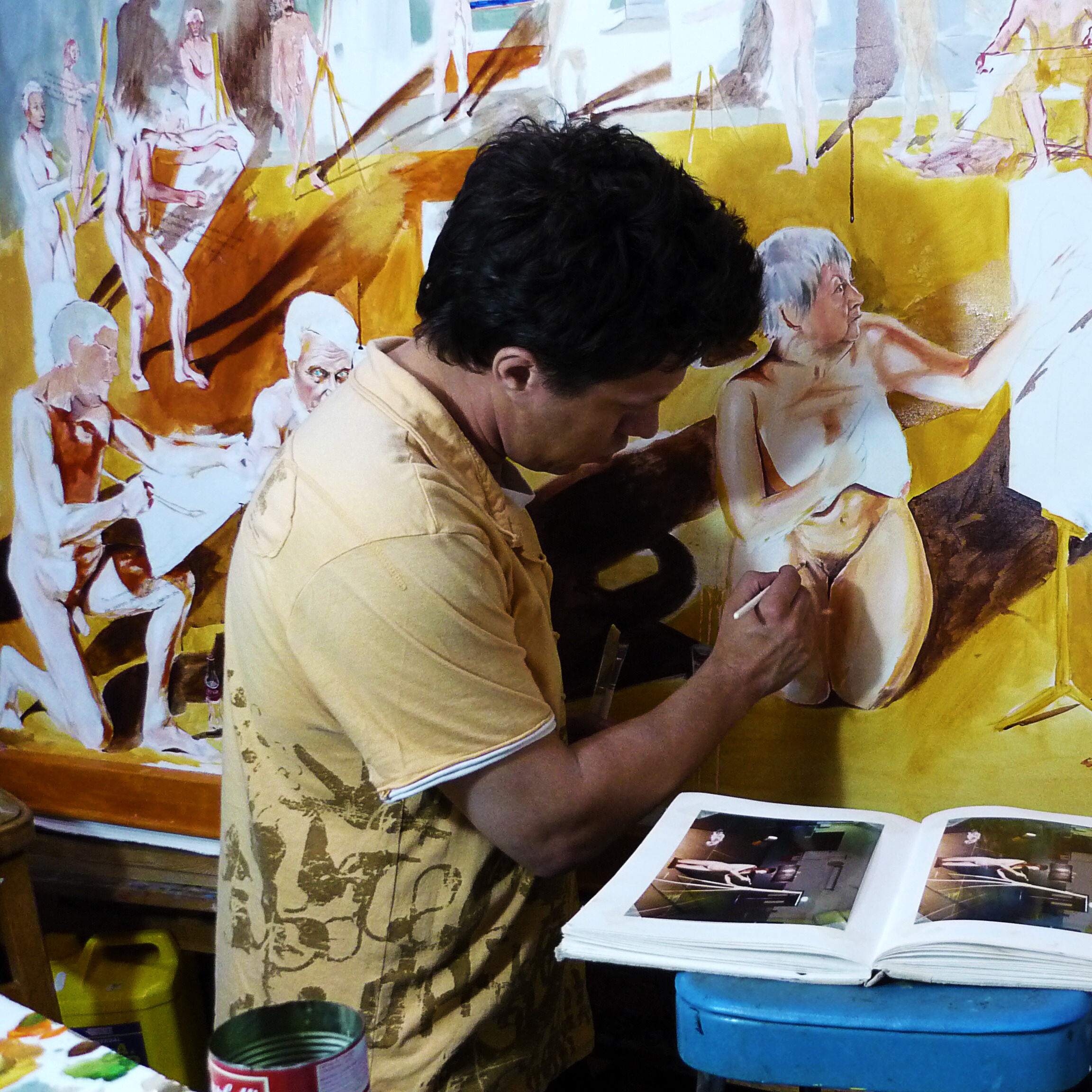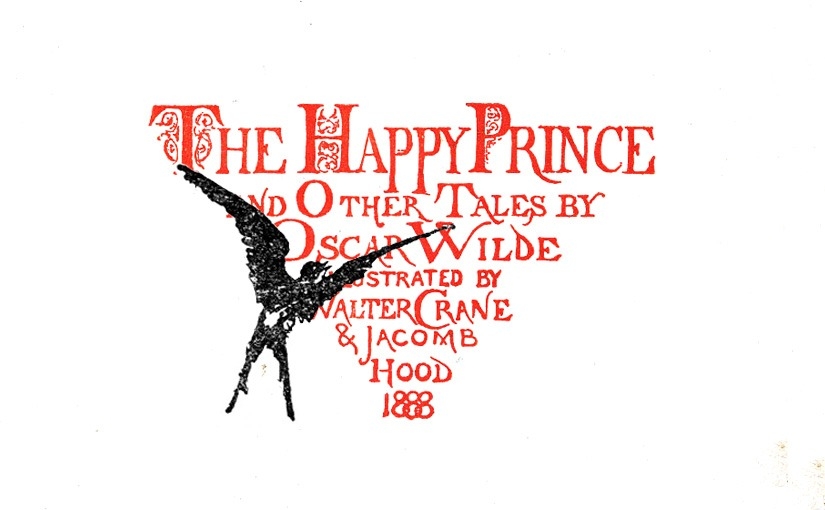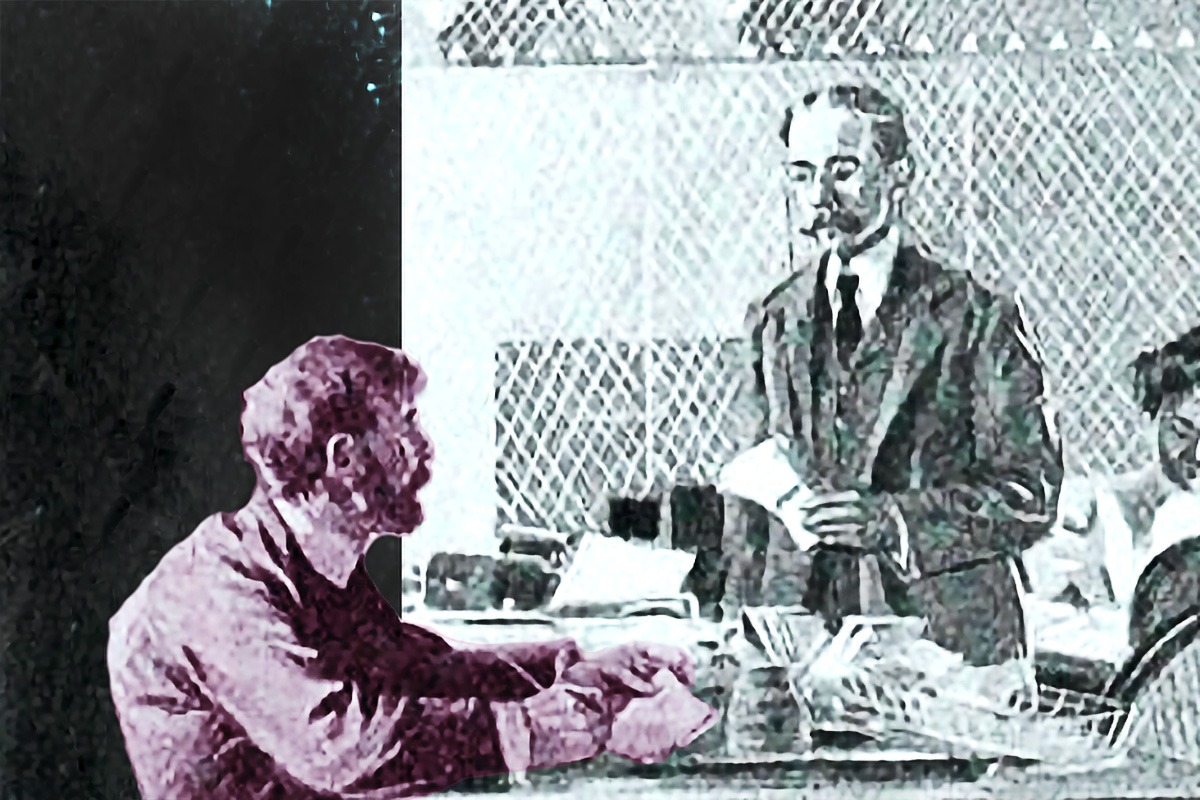VITTORIO PELOSI IS A U.K.-BASED ARTIST and the founder of Intentism, a new art movement that ascribes the meaning of an artwork to the artist’s intention and not to the interpretation of the viewer; or multiple interpretations of multiple viewers. From Vittorio’s Intentism: Resurrection of the Artist, here’s a definition of:
Intentism noun
\in-‘tentizəm\
Intentism is a movement of artists, authors and musicians who believe that art can convey an artist’s intended message to his or her intended audience. As a movement it both recognizes and celebrates the relationship between an artist’s creation and its creator.
Think of the classic (albeit hacky) thought experiment: a monkey randomly (i.e., unintentionally) hitting keys on a typewriter for an infinite amount of time eventually overcomes the improbability of rewriting the works of Shakespeare. In this scenario, what distinguishes the monkey’s accidentally composed Hamlet from Shakespeare’s intentionally written Hamlet in the reader’s eyes? Nothing, really, and thus who cares about Shakespeare? Yet, for us, the thought experiment is only interesting insomuch that we acknowledge that Shakespeare was not a monkey mindlessly punching at a typewriter (or scribbling with a quill). We acknowledge that Shakespeare had intent.
The mid-20th century New Critics essentially declared the reader incapable of distinguishing the artist from the monkey, and so determined authorial intent as irrelevant to understanding an artwork’s meaning. Soon after, the mid-to-late 20th century postmodernists declared us all word-grappling monkeys in an incredibly cynical, condescending worldview that diminished, or deconstructed, art into meaningless fragments; and thus declared the role of artist as superfluous, artificial, dead.
Postmodernism is hip and cynical and cool, and no doubt I’m often attracted to all of that. But as David Foster Wallace suggested, perhaps this sort of fun, self-diminishing meaninglessness is actually not fun at all in the grand scheme of things, because perhaps there is a grand, unfragmented scheme to consider, and to consider even on the lower phylum frequencies (lower even than monkeys), such as that of the lobster, which — funny enough — has recently received considerable consideration by the likes of Jordan B. Peterson, whose anti-postmodern ideas I explored in my smart-ass poem “Coddling Away” (link here) which lead me to stumble upon Vittorio Pelosi’s painting The School of Postmodernism and consequently familiarize myself with his Intentist movement; but so and anyways I’m not denying the attractiveness of postmodernism here nor do I necessarily expect my readers here to know the complete ins and outs of postmodernism and critical theory, or to even care for all the academic jargon, but I hope to at least impress upon you the overarching implications of this debate on authorial intent, which I find at the least endlessly fascinating. It’s an ongoing debate, yet one that’s at a critical turning point thanks to the internet.
For the sake of art, I’m on the side of the artists, and so I’m incredibly pleased to see new movements such as Vittorio Pelosi’s Intentism that seek to direct us in a much more positive, constructive, and meaningful direction otherwise denied us by postmodernism.
The following interview was conducted via e-mail.
***
INTERVIEW WITH VITTORIO PELOSI
Ryan: We are linked by Jordan B. Peterson. Exploring his ideas on order vs. chaos, identity vs. individual in my poem “Coddling Away” lead me to your painting “The School of Postmodernism.” In our JBP-era of increased self-accountability and -responsibility, do you sense a rising potential for Intentism?
Vittorio: I take it that your reference to Intentism comes from the second statement of our manifesto: Intentists believe a confused, hidden or denied intention can lead to ZERO accountability. This is bad for art and bad for society. [Q.v. Intentism Manifesto.]
Although Peterson’s influence has sky-rocketed in the last few years, his views often polarize people and I’ve yet to see a re-think in terms of self-accountability and responsibility on a large enough scale sufficient to be labelled a new era. Having said that, it is an interesting time to consider these themes as we are also in the middle of the #metoo movement that at its best challenges us to be aware that our behaviour matters. Intentists look at the way we attribute actions in everyday life to an agent and ask the question why we don’t feel it is necessary in the arts.
For example — take a look at these two pairs of analogous events: After a violent altercation two men in Glasgow run over a 39 year old man, leaving him for dead; an OAP fails to see a pedestrian and knocks him down. A man incensed over unrequited love tracks down the object of his desires and shoots her dead; a woman from Cape Girardeau shoots and kills her attacker during an attempted rape. All tragic events, but should they be treated as equally terrible? In law, distinctions are made based on the perpetrator’s intentions.
There are various technical arguments surrounding whether an art work (whether visual or literary) should be tied to the author as these examples. For example, should the method of interpreting ambiguous poetry be the same as a shopping list? However, making it a hermeneutical principle to kill off the author (like Barthes in his seminal work ‘The Death of the Author’) does open you up to the possibility of a loss of accountability. For example, one of the fathers of postmodernism, Martin Heidegger was a National Socialist and in his infamous Black Notebooks wrote several anti-Semitic passages. Do we criticize the work alone or do we hold Heidegger accountable?
So, in sum, we are hopeful that there might be a potential for greater interest in Intentism. We have become one the fastest growing art movements in recent years. However, we do recognize that there is a long way to go. Although we have been invited to speak at numerous art universities and The Royal College of Art organized a panel debate on our movement, we still face a good deal of opposition. The Intentists a few years back contacted 100 of the most prominent art critics in the UK. We had one positive reply and many very aggressive responses. I think the situation is made all the more difficult because the undergraduates that soaked up the postmodernism thinking of the sixties have become the professors teaching this over the last few decades.
Likewise, with the rise of online anonymity, do you sense a heightened anxiety around the question of intent?
This again is a very interesting area as social media interaction is too new to have had the same amount of analysis as ‘traditional literature.’ It is certainly clear that the cloak of anonymity seems to afford writers with a freedom to not self-regulate in the way that they would in say, a face-face-encounter. The Intentists created a work that I think demonstrates that we have an innate interest in the source of any communication — particularly when it’s provocative or sensitive.
In Confessional (2011), we went to the Essex music festival Brownstock. Evoking Emin’s ‘Everyone I have Ever Slept with 1963-1995’ tent, we wanted to create an installation work that would appeal to festival goers and reveal our interest in authorship. A small white tent was set up at the festival. Inside were candles and choral music that created an introspective atmosphere. Festival goers were invited to go inside alone and write a confession with a marker pen on the inside of the tent. The only condition was that it had to be true. We promised not to go in during or even afterwards but insisted on taking a head shot of each ‘confessor.’ The work had a range of absurd to very serious confessions and was exhibited with all the head-shots on the gallery wall. Gallery visitors were encouraged to go in one at a time inside the tent and read the confessions. Whether they then looked at the head-shots and mused over the authorship was up to them. We found that anonymous texts actually fueled the viewer’s interest to discover who the author was.

In your bio you cited working on “The School of Postmodernism” as your inspiration for Intentism. What about working on this painting lead you to consider the importance of artist’s intentions?
Well, it wasn’t only this work that was a ‘light-bulb’ moment. I had been aware for many years that in literary theory the reader had become empowered to look at a text and give opinions. As long as these were expressed as what it means to me, then it was considered a plausible reading. I had no idea that this was the outworking of the School of the New Critics, but it seemed strange to me that cultural context, the author’s intention etc. was not considered significant. Something else that I should add is this. Even if you could make the case that the Romantic model of the 19th Century that elevated the writer as the ‘god-author’ of the text was too simple; even if Barthes was right that all texts are a ‘textile of quotations’ and that language is slippery and meaning may always be ‘deferred’ (Derrida); the vast majority of the theories were focusing on texts, not the visual arts. Yes, Heidegger and Derrida wrote a little on the visual arts and Barthes wrote extensively on the semiotics of wrestling, but when they did, all their theories were literary theories not visual ones. Language is intrinsically different. It is linear — we read from one side of the page to another. In other words we have an ‘order expectation’ with language. This fits with the postmodern beliefs that since our life is linear and so are texts, meaning can only be found when these two narratives combine — Heidegger called this the ‘fusion of horizons.’ In essence, with the baggage of our lives, we are unable to understand a work objectively at all and any meaning can only come through the lens of our experience. Again, there is undoubtedly something in this, but the theory was derived from texts. Many visual art works are ‘anarrative’ — the viewer can begin and end in different places. So, this is one area where postmodern theory breaks down. I wanted to show in the painting that it is absurd to think we can’t grasp the author’s intentions. Perhaps we can never understand a work perfectly but we can get close. Instead of a hermeneutical circle where we go round and round the text indefinitely, a better understanding is a hermeneutical ‘spiral’ whereby careful study of the author, culture, etc. we can get closer and closer. I attempted to represent this by choosing what is arguably the most objective art skill — drawing the life model.
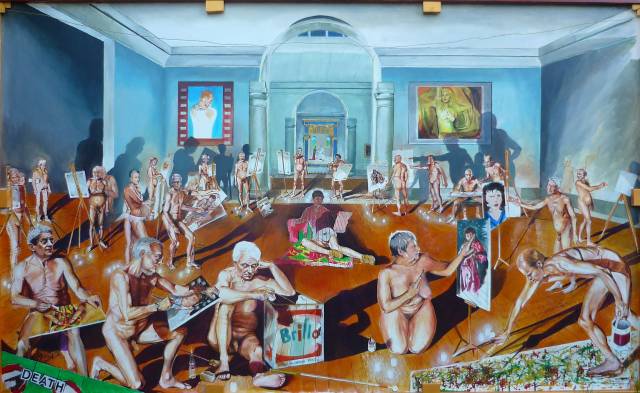
I then chose to make each student an influential postmodern thinker analysing intently the human figure. However, when you look at each of their works, they are interpretations through the lens of their postmodern theories. For example, in Barthes’ painting the model has become a wrestler. The absurdity is that we can see they are studying the human form but we can see quite clearly that what they are depicting is not what they see. Ironically, the only ones that are not aware of their blind bias are the philosophers themselves. By the way, I hope you noticed that the title ‘The School of Postmodernism’ is similar to Raphael’s ‘The School of Athens.’
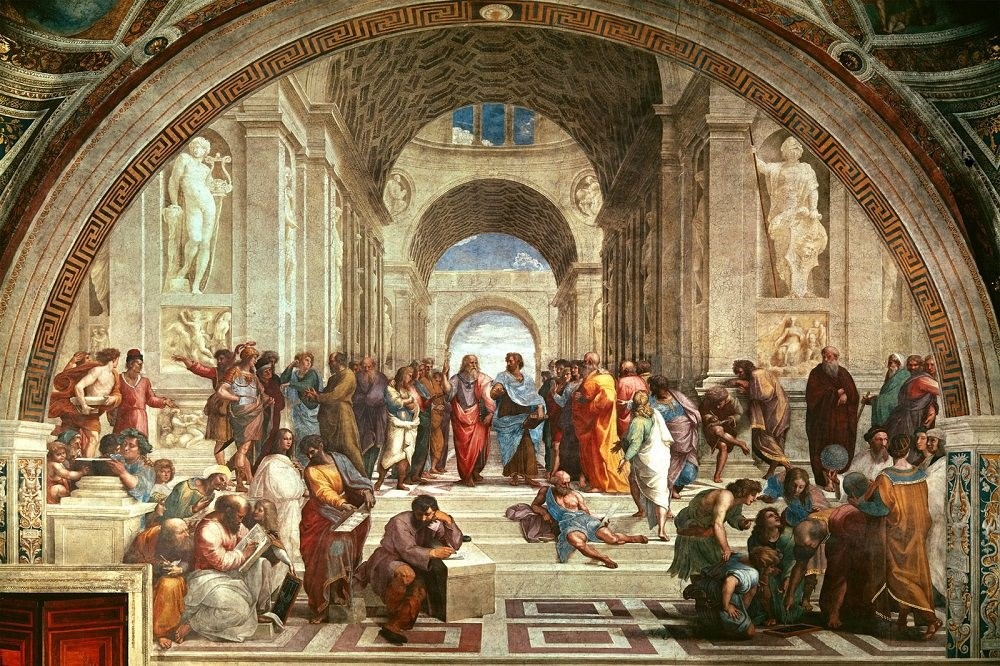
Raphael’s painting actually does look like artists around a model — except that Raphael depicts Greek philosophers. Therefore, the majority of the figures in my work are positioned similarly to the subjects in Raphael’s painting. I then needed a setting. Apparently the arches in Raphael’s painting are architecturally impossible to be built. Postmodern architect Robert Venturi designed the Salisbury Wing of the National Gallery with arches to deceive the eye. It has a very similar look to Raphael’s and gave me the opportunity to have a postmodern setting. Finally, Raphael has a self portrait of him in his work and I have included myself too. Finally, the end wall painting in the Salisbury Wing is called ‘The Incredulity of St.Thomas’ as Thomas doubts a resurrected Christ. I have replaced Thomas with myself doubting the father of much postmodernism — Nietzsche.
Also, I love that the postmodernists are naked. Why are they naked?
They are naked for a number of reasons. Firstly, the various thinkers that I believed to be foundational to postmodern thinking are from a range of decades with different styles of clothes so to give the work a context and a believability, they needed something unifying — the human body. Secondly, I wanted to give a few ironic postmodern references. Therefore, since in the studio, the model is naked and the artists are clothed, I decided to reverse this — but not entirely. Much of postmodernism is hostile towards anything binary, so the model is actually partially clothed. Thirdly, I considered that there is immense irony in the fact that the very writers that argued for the Death of the Author had become celebrities and rich through their own writings. Therefore, I felt there was an element of the Emperor’s New Clothes about it — another reason for them to be naked.
I found the distinction between “meaning” vs. “significance” particularly helpful in understanding Intentism. For the reader, could you elaborate on how meaning and significance play into the Intentist’s worldview?
Of course. This is something that was first worked through and named by E.D. Hirsch Jr. in his seminal work The Validity in Interpretation. He basically said that the meaning of a work is the outworking of the intention of the author/artist. Professor Paisley Livingston in his book Art and Intention has helpfully defined intention as a ‘performance expectation.’ Therefore, if this expectation is successfully visualized and conceived in the work, then the meaning is this intention. However, we may have different ideas about the work — some may be false and unhelpful — others, like how we might view a melody as ‘our song’ with memories and associations, are important but still not the work’s meaning. These things we attribute to a work are its ‘significances’ — i.e. how the work is significant to me.
The New Critics’ “Intentional Fallacy,” Roland Barthes’ “The Death of the Artist” – are there any other seminal anti-artist works that you view as oppositional to Intentism?
Well, although there are some undoubtedly strong pieces of recent art out there, we feel that much has become anaemic and voiceless. What if an artist wants his or her voice to be heard? What if he or she believes in a message? What if an artist wants his or her work to be polemical and influence his or her audience? Intentists feel there was a time when artists were at the vanguard of thought and society. We are not against work that is for aesthetic pleasure alone, but we don’t want to be gagged by a philosophy if we DO want to stand for something. One of the most well-known examples of the Death of the Author/Artist and the birth of the viewer was the Pompidou Centre’s exhibition ‘Voids’ in 2009 which had nine rooms all with no content at all — a retrospective of various artists over fifty years whose work had been nothing at all.
I’m a fan of several works deemed “postmodern,” such as Thomas Pynchon’s The Crying of Lot 49, Nabokov’s Lolita, and Warhol’s pop art; yet, despite their hip postmodern cynicism, I see these works as ultimately sympathetic to the human struggle for meaning. Do you see a significant split between early postmodernism and late “post-structural” postmodernism, which seems to dismiss and (even worse) mock the search for meaning altogether?
I think that postmodern ideas have certainly developed over time. It is interesting that you equate postmodernism with cynicism and the antidote to this as having sympathy ‘to the human struggle for meaning.’ Colin Lyas, a philosopher from Lancaster University and author of Aesthetics has been writing about postmodernism and the Death Thesis for many decades and he thinks one of the most impactful events was the First World War. He particularly cites the Battle of the Somme as being an event of such meaningless tragedy that it had a significant impact on our attitude to purpose and meaning. Such was the scale of human loss that it blew away much of the optimism of Modernism and the Enlightenment. It is also worth noting that the most well-known document against intentionalism by Wimsatt and Beardsley entitled ‘The Intentional Fallacy’ was written in 1946, just a year after the ending of the Second World War. Finally, Barthes’ ‘Death of the Author’ was written at a time of great suspicion of all authority – particularly in France with the 1968 Paris riots. The author had become a symbol of authority and, indeed, tyranny over the text and it was the perfect time and place for academia to give a rationale to this sentiment. So, like I say, there is this progression, and the search for meaning did seem to gradually become more irrelevant. Derrida would then argue that there is ‘nothing outside the text’ and all meaning is deferred and that, although there are some interpretations of a work that can be discarded, there is ALWAYS more than one valid interpretation. I think in literary theory this period was when the search for objective author/meaning was most rejected. However, I do see some more nuanced hermeneutical positions in more recent decades. Paul Ricoeur’s position was that meaning is not the world ‘behind’ the text (the author), not the world ‘of’ the text (The New Critics), but the world ‘in front’ of text. In essence, he allowed for some play between author and reader in this ‘world.’ Stanley Fish has more recently argued that the singular viewer/reader does not decide a text’s meaning, but the ‘interpretative community,’ which could be a generation or a culture etc. Unfortunately, as has been the case for a while, I think art is lagging behind this more sympathetic recent theory and is still in the main hostile towards an author’s intention.
In Roland Barthes’ “The Death of the Artist,” Barthes likened the death of the author to a sort of secular dismissal of God. Are there similar theological implications in Intentism’s resurrection of the author?
Intentism is an art movement whose adherents believe that not only is it hermeneutically wrong to dismiss the artist, but it leads to weaker art work. There are Intentists whose world views cover the whole spectrum of belief and lack of. Therefore, it has no inherent affinity with theology as such, but you are right, meaning and authorship is an argument espoused in theological debate. In fact, in various books and debates Intentists have used an analogy based in theology: As a thought experiment, would there be any difference between a hyperrealistic painting of nature and nature itself? Would one or both have meaning? Richard Dawkins, the well-known ‘new-atheist’ and academic has often poured scorn on those that ask him ‘why’ questions about the world. He believes them to be unscientific. Science answers the ‘how’ questions. I believe, he is right because ‘why’ questions are asking about purpose and intention and Dawkins knows this would invoke a Purpose-Giver and Intender of the universe. Going back to the painting, Intentists would say the hyperrealistic painting would (at least to a secular person) have a difference in meaning because a mind has created it with purpose and significance and design. We have recently created an Intentist work as an example of this:

The work above is entitled ‘First and Second Slip’. There is a piece of slip that had fallen off the artist’s work station and was about to be disposed of. However, the artist decided to take another piece of clay, add water and shape it to be very similar to the first. Visually they appear the same. However, one is waste and the other was carefully shaped with creative precision to make a statement about intention. In sum, demonstrating that since the work appears the same and has the same physical properties, meaning here must be found outside of the work (in the artist’s intention). The fact that the artist has not disclosed which piece of clay is which and it is impossible to discern it from the work alone makes this piece more impactful.
Okay, for the next one I have a three-parter for us to explore what is (in my opinion) one of the most complex through-lines in recent art history:
Part 1. Infamous murder-cult leader Charles Manson interpreted The Beatles’ White Album as a cryptic, Biblical directive for Manson to personally initiate “helter skelter,” an apocalyptic race war between the blacks and the whites. Through his somewhat generic “hippie” music, Manson intended to attract the Beatles’ attention and ultimately inspire global violence. How would an Intentist critique Manson’s music?
Intentists have been careful to separate art criticism from Intentionalism. That is to say, Intentist theory about authorship is primarily epistemological and although we all have opinions on ‘good’ or ‘bad’ art, we have not linked them to the movement. The reason why our manifesto says that the Death Thesis can lead to zero accountability is that without intention we cannot even engage in the conversation. A common position among intentionalist academics is that although a successful work is a work that realizes the ‘performance expectation’ of the intention, a work that realizes a mediocre intention can be critiqued as being inferior to a complex, challenging intention. I suspect that is where this example would be debated. Although we would be concerned about attributing crime to someone’s interpretation of an artwork, we are concerned that many artists do assent to contradictory beliefs — namely, that true art inspires, but the artist is not even partially responsible for any inspired responses.
Part 2. Provocative musician Marilyn Manson, who partially derived his stage name from Charles Manson, created obscene art with the intention to “provoke people so they think,” as he stated in a 1998 appearance on David Letterman’s show; a much nobler intention than Charles Manson’s “helter skelter” ambitions. Even so, Marilyn Manson has received accusations of corrupting society and promoting school shootings. How would an Intentist measure Marilyn’s obscenity in relation to his intention?
Again, Intentists are concerned with meaning and the freedom for an artist to claim their voice back rather than arguing what is good or bad art. Intentist theory gives us the strongest theoretical basis to have this debate. If all meaning is interpretation from the viewer alone, on what basis can we make moral judgments since it is theoretically possible for one work to be wholesome to one and morally bankrupt to another.
Part 3. Suppose we combine Charles and Marilyn into a single artist who creates obscene art with the intention of initiating a “helter skelter” apocalypse. Would this warrant art censorship in the Intentist’s worldview?
We are aware that from the 1920’s The National Socialists labelled any art not conforming to their values ‘Degenerate art’ and removed more than 20,000 artworks. So, although we would all undoubtedly have strong viewpoints on this theoretical art work, as a movement, we would be wary of censorship. As I say, intention creates the possibility of having the debate. Intentists would argue that as art is a mode of human gesture, this debate about Marilyn Manson’s gesture to the world is of real importance. However, that is where the movement’s theory leaves us. From there we would have our personal convictions.
The “Intentism Manifesto” concludes that “Intentism is a force for good.” What are the positive social effects of Intentism?
As mentioned above, arguing that a work is the external human gesture to the world of a creative mind means that an artist has his or her voice back. We are no longer gagged. We ARE able to get our message across — even imperfectly. That means we can be a voice to the voiceless and be pioneers in society. It is of interest that in dialogue with linguist Chomsky on postmodernism and responsibility, he cites various political and social problems in Latin America as a result of the postmodern indifference to truth. However, if we have a direct link from our intentions to the work, then we have a responsibility. If my work is overtly racist or homophobic or inciting violence, then I am accountable for those ideas.
Where can we learn more about Intentism and your work?
We have a website (intentism.org) full of art and theory. We also have a YouTube channel with dozens of videos and a regular video taster called ‘Intentist Bites.’ We can be directly contacted at: intentism@gmail.com.
